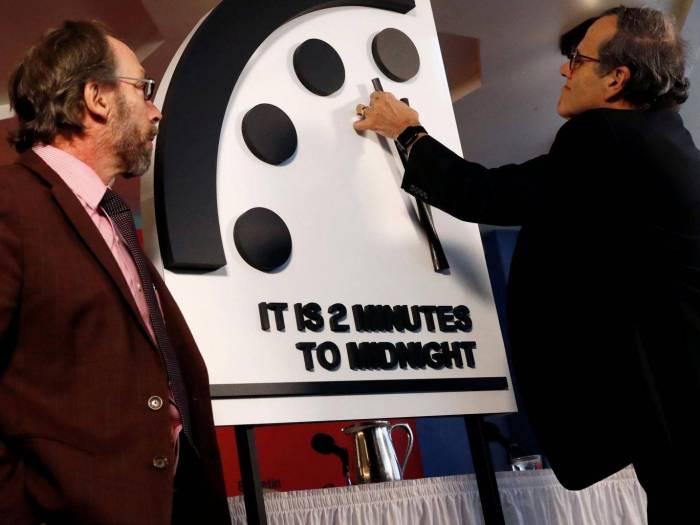The decision to change the clock’s time follows an extremely unsettling year in global politics. Obscene threats of nuclear annihilation pass on a seemingly monthly basis between Trump and Kim Jong-un. The climate crisis accelerates further beyond our effective control. In the past week alone, Western generals have warned of looming war with Russia.
In such a climate, the clock, which was first set in 1947, is an ominous reminder of the global threat of nuclear war. It is a symbol of humanity’s proximity to global catastrophe – represented by midnight on the analogue face.
It is maintained by the Bulletin of the Atomic Scientists, a non-profit research organisation that emerged from the Manhattan Project. The bulletin publishes a journal and aims to bring together scientists, policymakers and activists, all united by a common concern for the existence of the human race. The journal is a resource of incalculable value, read by scholars, policymakers and concerned citizens alike. For six decades it has published sober and nuanced analysis of the many and various planetary threats.
Yet the Doomsday Clock, however well intentioned its custodians, undermines the bulletin’s stated mission to put “issues and events into context”. This is why it should be retired.
Countdown to Armageddon?
The bad news rolls in ad infinitum. The dangers are real and tangible. It would simply be remiss to accuse the bulletin of scaremongering, but the Doomsday Clock is an increasingly inadequate tool for raising public and political awareness of the most pressing global challenges. It may even be dangerous.
The crux of the problem is that the clock – or indeed any clock – is an exceedingly poor metaphor for the level of global threat. Its “time” is devoid of any real meaning. It was only initially set at seven minutes to midnight, because this “looked good to the eye” of the artist who drew it.
More importantly, it strongly implies that history tends towards inevitable disaster. While the bulletin maintains that it is not aiming to predict catastrophe, prediction is implicit in its visualisation. We have progressed towards the apocalypse by five figurative minutes since the clock was first set at seven minutes to midnight in 1947, even though the hands were temporarily moved backwards under the more optimistic global outlook of the 1990s.
Out of time
Is there any more powerful reminder of human futility and helplessness than the inexorable march of time? The clock contributes to despair and fatalism, in the face of complex and urgent political problems, encouraging generalised panic.
These problems demand active struggle, and as environmentalist George Monbiot cautioned three years ago, despair breeds defeat. A popular Google search wonders “what happens when the Doomsday Clock hits midnight”. This suggests that, in the popular imagination, the clock has developed causal powers of its own.
It may even contribute to the threats themselves. Scholars of security and international politics have long discussed how geopolitical threats such as nuclear war are partly constituted by public discourse and culture.
We already live in a fractious and often militaristic political climate. Each announcement of the clock’s periodic changes is accompanied by a rash of news articles depicting mushroom clouds, stony-faced dictators and parades of military hardware. Comment threads fill with nationalistic bile. The Daily Star responded ahead of the latest change by visualising the effects of a North Korean nuclear strike on London, which as far as we know is currently a physical impossibility.
Nevertheless, a widespread belief that a nation is under threat can create conditions under which preemptive offensive action is politically feasible and publicly acceptable, exacerbating the likelihood of conflict. The bulletin is normally a voice of reason rising over the din. But through the clock, it unwittingly contributes to these increasingly fragile conditions.
Maybe the Doomsday Clock was a more apt metaphor during the Cold War – an era of hair-triggers, false alarms and automatic missile launch systems, when Europe was, in a very real sense, minutes away from annihilation at all times. Maybe it really did induce national leaders to step back from the brink of Armageddon. And just maybe the clock’s keepers gain some small comfort, a sense of control over humanity’s collective fate, from the ritualistic moving of its terrible hands.
But while the clock may be a striking brand, it is not fit for purpose. Scholarly and scientific outreach must adapt to today’s political realities. The venerable bulletin must continue its mission – but it should call time on the Doomsday Clock.
The Independent
More about: Doomsday
















































